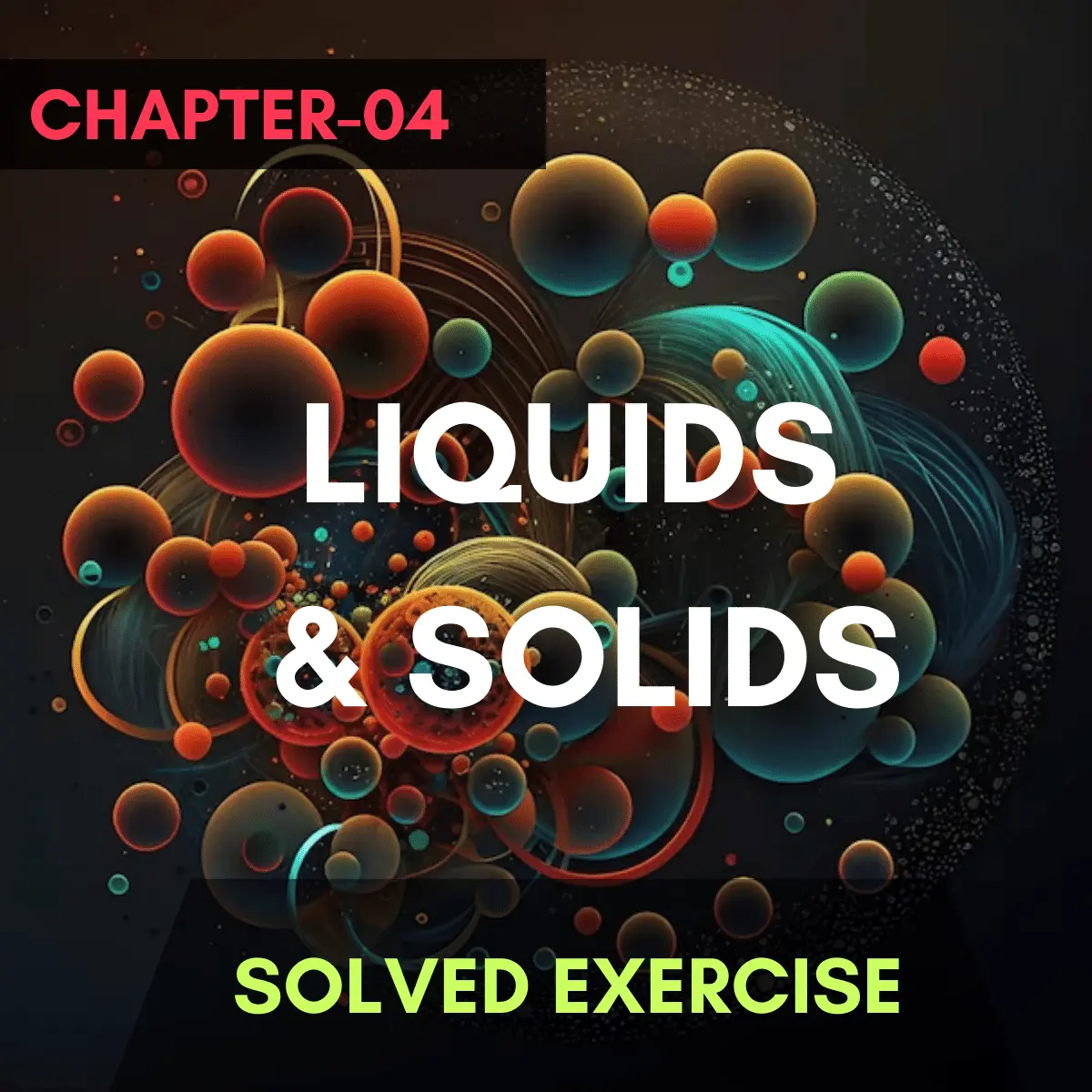LIQUIDS & SOLIDS
Q.1. Choose the best answers from the given choices.
(i) London dispersion forces are the only forces present among the:
(a) Molecules of water in liquid state.
(b) Atoms of helium in gaseous state at high temperature.
(c) Molecules of solid iodine.
(d) Molecules of hydrogen chloride gas.
Ans: (c) Molecules of solid iodine.
Explanation: London dispersion forces are the only forces present among the molecules of solid iodine because iodine molecules (I2) are non-polar, and the non-polar molecules interact only through London dispersion forces which are temporarily produced when their electronic clouds are distorted and temporary dipoles are created on them. Polar molecules, on the other hand, have London forces as well as dipole-dipole forces.
(ii) Acetone and chloroform are soluble into each other due to:
(a) Intermolecular hydrogen bonding
(b) Ion-dipole interaction
(c) Instantaneous dipole
(d) All of the above
Ans: (a) Intermolecular hydrogen bonding
Explanation: Acetone and chloroform are soluble into each other because both are polar molecules and are capable of making strong hydrogen bonding with each other. Although, neither acetone nor chloroform have hydrogen bonding in pure form, yet when they are mixed, they can make H-bonds due the presence of highly partial positive H-atom of chloroform.
(iii) NH3 shows maximum boiling point among the hydrides of Vth group elements due to:
(a) Very small size of nitrogen
(b) Lone pair of electrons present on nitrogen
(c) Enhanced electronegative character of nitrogen
(d) Pyramidal structure of NH3
Ans: (c) Enhanced electronegative character of nitrogen
Explanation: Owing to the presence of a lone pair of electrons on nitrogen, its electronegative character is enhanced and as a result NH3 molecules establish hydrogen bonds that increase the boiling point of NH3 among other hydrides of group VA.
(iv) When water freezes at 0oC, its density decreases due to:
(a) Cubic structure of ice
(b) Empty spaces present in the structure of ice
(c) Change of bond lengths
(d) Change of bond angles
Ans: (b) Empty spaces present in the structure of ice.
Explanation: Each water molecule can make four H-bonds with four neighboring molecules. In liquid state, water molecules are in random motion, so they roughly penetrate into each other. When, water is frozen, the molecules are arranged regularly in a tetrahedral manner, so that large empty spaces are created between them. Due to these empty spaces, the volume of ice increases while its density decreases.
(v) In order to mention the boiling point of water at 110oC, the external pressure should be:
(a) Between 760 torr and 1200 torr
(b) Between 200 torr and 760 torr
(c) 765 torr
(d) Any value of pressure
Ans: (a) Between 760 torr and 1200 torr
Explanation: Boiling point is directly proportional to the external atmospheric pressure. At 760 torr/mm Hg, water boils at 100oC. In order to boil water at temperature higher than its boiling point like 110oC, pressure must be increased above normal atmospheric pressure. So, the pressure between 760 torr and 1200 torr is the only viable option for boiling water at 110oC.
Q.2. Fill in the blanks with suitable words:
(i) The polarizability of noble gases __________ down the group and results in the increase in their boiling points.
(increases)
(ii) __________ is developed in acetone and chloroform when they are mixed together.
(Hydrogen bonding)
(iii) Exceptionally weak ___________ of HF is due to strong hydrogen bonding present in it.
(acidic strength)
(iv) The concept of dynamic equilibrium is the ultimate __________ of all reversible systems.
(fate/goal)
(v) ∆Hv of C6H14 should be _________ than that of C2H6.
(higher)
(vi) During the formation of ice from liquid water, there is a __________ % increase of volume.
(9%)
(vii) The rate of increase of vapour pressure of water __________ at higher temperatures.
(increases)
(viii) A layer of ice on the surface of water __________ the water underneath for the further heat loss.
(prevents)
(ix) Evaporation is a _______ process.
(cooling)
(x) Liquid crystals are used in the display of ___________ devices.
(electrical)
Q.3. Indicate true or false as the case may be
(i) Dipole-dipole forces are weaker than dipole-induced dipole forces.
(False)
Correct: Dipole-dipole forces are stronger than dipole-induced dipole forces.
(ii) The ion dipole interactions are responsible for the dissolution of an ionic substance in water.
(True)
(iii) The high polarizability of iodine is responsible for its existence in solid form and its difference from other halogens.
(True)
(iv) The strong hydrogen bonding in H2S makes it different from water.
(False)
Correct: The weak dipole-dipole forces make it different from water.
(v) Hydrocarbons are soluble in water because they are polar compounds.
(False)
Correct: Hydrocarbons are insoluble in water because they are non-polar molecules.
(vi) The viscosities of liquids partially depend upon the extent of hydrogen bonding.
(True)
(vii) The state of equilibrium between liquid state and vapours is dynamic in nature.
(True)
(viii) Heat of vaporization of liquids depend upon the intermolecular forces of attraction present between their molecules.
(True)
(ix) Ice does not show any vapour pressure on its surface at -1oC.
(False)
Correct: Ice shows very low vapour pressure on its surface at -1oC.
(x) Boiling point of a liquid is independent of external pressure.
(False)
Correct: Boiling point of a liquid depends upon external pressure.

